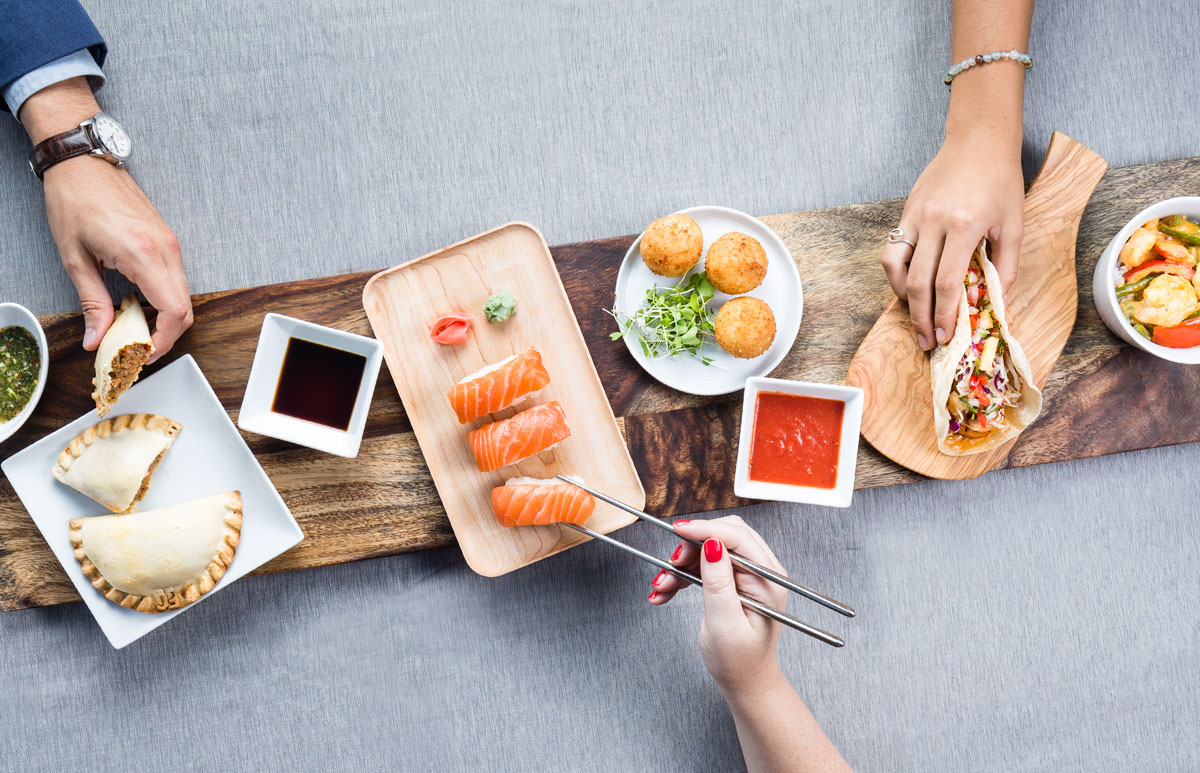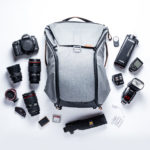I get frequent questions about what kind of camera or lenses I use for food photography; so I put together a list to share with you of what’s in my food photography bag for photo shoot. It’s great to see the gear that other food photographers are using for ideas on what might also work for you.
Going to a remote photo shoot is quite a bit different than shooting in the home studio. If you don’t bring it with you, using it is out of the question. The reality is that there’s a lot more in the bag than just the camera and lenses. Most of it is pretty basic stuff, and that’s often what is most useful.

One of my goals is to have a minimalist photography gear bag and only bring the essentials with me. Having minimal gear with you means there is less packing, carrying around, and unpacking that you will have to do. Also, the more you have, means the more you are buying an expensive piece of gear that often goes unused. I only buy something new if I have a specific need for it in the near future, and that it will be reused again and again.
While I try to bring the minimum needed (which a lot of the time isn’t super minimal at all), it’s important to have something to cover a variety of situations you might deal with.
On an ideal shoot; most of the gear I brought with me gets to stay in the car. A simple setup is quickest and allows you to focus on shooting and interacting with your client, which is what I enjoy the most. Of course, the ideal situation isn’t often the case.
A backup plan: It’s a little scary heading to a photo shoot knowing that if one piece of gear fails, everything could go to $#*& if you don’t have a backup plan in place. It’s just not practical to carry a backup of every piece of equipment you might need.
One of the best pieces of backup equipment you can carry with you is the phone numbers to a photographer friend (or three) who could help you out in a bad situation. Plan for a failure and you probably won’t have one (Murphy’s law).
My Current Food Photography Equipment Setup
The links below are affiliate links, which means that if you choose to make a purchase, I will earn a commission. This commission comes at no additional cost to you and helps support this site.
This is what is generally in my bag if I am heading out on a food photo shoot.
The quick list:
Peak Design Everyday Backpack 30L
Canon EOS 5D Mark III Full Frame DSLR Camera Body
Canon EF 50mm f/1.4 USM Lens
Canon EF 100mm f/2.8L IS USM Macro Lens
Canon EF 16-35mm f/4L IS USM Lens
2 x Godox AD200 200Ws 2.4G TTL Flash Strobe 1/8000 HSS Cordless Monolight
Godox Xpro-C TTL Wireless Flash Trigger for Canon
Canon Speedlite 600EX II-RT Flash
Godox X1C TTL Wireless Speedlite Receiver
Manfrotto MT055CXPRO3 055 Carbon Fiber 3-Section Tripod with Horizontal Column
Manfrotto 324RC2 grip tripod ball head
Manfrotto 131DB Trpod Arm for overhead shots
Light Stands
Glow 24 x 36″ Softbox
Glow Egg Crate Grid for 24×36″ Softbox
Mini softbox for Speedlite Flash
43″ 5-in-1 Collapsable Reflector / Diffuser | 24″ x 36″ Version
Tether Cable
Canon RC-6 Wireless Remote Controller
SanDisk 128GB Ultra UHS-I Class 10 SDXC Memory Cards
Panasonic eneloop AA Rechargeable Batteries
Extra Canon Camera Battery
Peak Design Lens Kit
Peak Design Capture
Black Rapid Camera Sling Strap
Apple Lightning to SD Card Camera Reader
The Bag
Peak Design Everyday Backpack 30L
While the camera might be the most important piece of gear, it all starts with the that will keep everything organized. I’ve had a lot of different bags in my life, and my latest bag is the best bag I have ever owned. It is superior in both in looks and functionality to any other bag. The quality of Peak Design products is so advanced; it’s like they thought of things that I didn’t know I needed a solution for.
Once I figured out how to configure all the inserts of the Everyday Backpack, everything has its place and fits securely. I can fit everything I need, plus more for a shoot. They also make a smaller version of the backpack in a 20L size.
Camera Equipment
Camera Body
Canon EOS 5D Mark III Full Frame DSLR Camera Body
I have been using Canon products ever since I took my first photography class. Canon professional cameras and lenses are total workhorses and are the most reliable and trustworthy electronics that I have ever owned. They just work and the quality of the imagery is spectacular.
Lenses
I carry three lenses with me for off-site food and restaurant photo shoots. Each lens has a specific purpose.
Canon EF 50mm f/1.4 USM Lens
If I could only bring one lens, it would be a 50 mm. The 50mm is my most versatile lens and a go-to for a variety of shots, from overhead to head-on angles to portraits.
Canon EF 100mm f/2.8L IS USM Macro Lens
Macro lenses seem like they were made for food photography, and this lens really is the ultimate lens for taking photos of food. The Canon 100mm macro is amazing for close up shots of food. Nothing else captures the detail that is possible with a macro lens.
Canon EF 16-35mm f/4L IS USM Lens
I use this ultra wide-angle lens primarily for interior and architectural shots. I also use it for large area flatlay shots where I would have to be way up on a ladder to fit the entire table in the frame. This lens is super sharp for an ultra wide angle lens and distortion is easily corrected in post-production.
I picked the f/4 version of the lens over the f/2.8 for two reasons. First, the price is less than half; and second, because architectural shots are usually f/8 +, and I wouldn’t really have any need for the wide aperture.
Lighting
Lighting is everything. Since optimal lighting conditions are tough to come by; I like to bring the optimal lighting conditions with me. A single Speedlite is really all that is needed for most photo shoots. It’s pretty amazing what you can do with a camera, one lens, a small light source and a light modifier.
Learn about the 4 Reasons to Learn Flash for Food Photography and the lighting equipment I use.


Hey Justin,
Great list of gear here. Why did you switch from the Godox square to the slightly larger (rectangular) one?
Hey Sara,
Thanks for checking it out! The larger softbox covers a bigger area and is a little more diverse in its uses. It also comes with a grid (egg crate) which I really like shooting with to focus the light a little more. 🙂
Just a single camera? No backup camera?
I do have a backup camera at home, but I generally don’t bring it with me on food shoots.
Hi,
Great article! Can you share how you pack the lightstands and softboxes when you go for your shoot?
Do you use a trolley case?
Hi Mandy! Thanks for reading it. To carry my lightstands I have a padded tripod bag. I actually recently switched softboxes to use the Glow EZLock line and they are amazing. The reason I love them so much is they are collapsible like an umbrella and come with their own carry cases. I use a large North Face expedition duffel to keep everything like that together. There are probably better “photography” gear options for that, but I use what I have.
I need to update this post to include info about the softboxes, but let me know if you want more details in the meantime.
Cheers!
Great Post! Thanks for sharing list of food photography gear. It helps me a lot.
Thanks for stopping by, Pat!
Great Post! Thanks for all the info.
Thanks, Laura! I know you use Nikon, but I hope there’s some useful info for you. 🙂